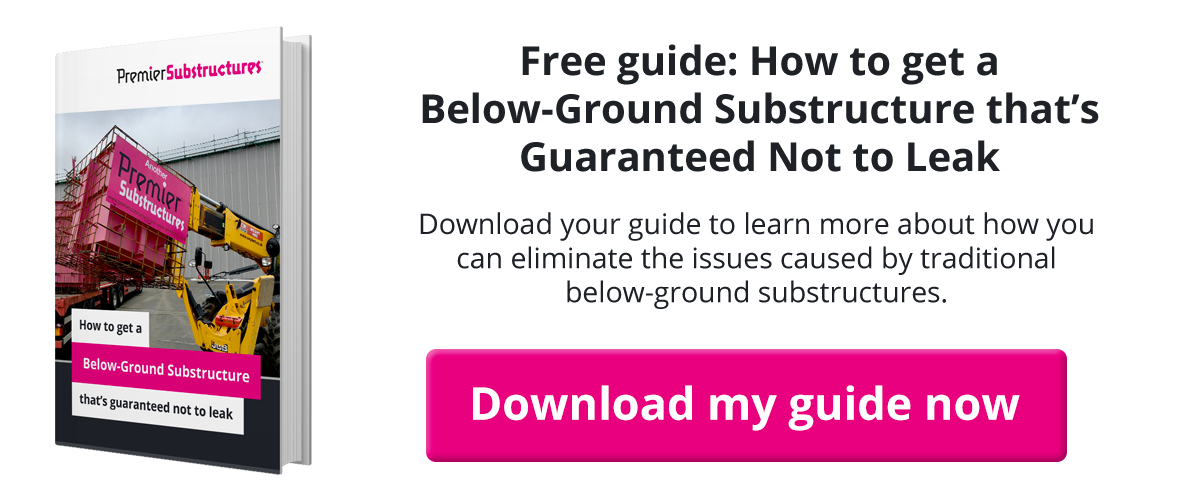Have you had a bad experience building below-ground level with in situ concrete?
Perhaps the process took a lot longer than expected. Or maybe once the construction process was complete, the product you were left with was substandard and wasn’t within the tolerances required. It may have even been prone to leaking – which is especially bad in high water table areas.
If you’re like many of the clients who contact us, you may also have had problems with precast concrete substructures being delivered to site, which then had to be returned due to quality issues.
As you’ll know, all of these issues can badly impact on your construction programme.
As a subcontractor who specialises in prefabricated steel substructures, I’m going to explain why these methods don’t work as well off-site – and an alternative solution.
Why won’t traditional in situ work as well as an off-site approach?
Typically, working below-ground on-site to build a substructure traditionally with in situ concrete can be very challenging. Often, the environment can be tricky, operatives are required to enter the excavation to complete the works. Adding to that, weather conditions can be bothersome.
There’s also the logistics of moving the materials, and general site constraints – all of which can have a large impact on the overall quality of the build. This can all lead to increased risk, stress and headaches for you and your team.
You can start to see why using an off-site method that is built in a factory environment, with a strict quality control atmosphere – with constant monitoring and controlling of the final product – can potentially lead to a much better result.
TIP: In situ is probably still the best solution if your substructure must cover a large area – for instance, a super basement.
Off-site construction methods compared
Now, lets take a look at your two main options for off-site below-ground construction.
Precast concrete
You’ve probably heard of – or even used – precast concrete as a below-ground construction method in the past. You may even have encountered the problem of quality issues and cracking as I mentioned above.
This is because the slab of a precast concrete substructure often has to be poured in situ. Typically, it’s only the side walls which are preconstructed off-site. There can still be problems with quality control, and the risk of cracks, leaks, and water ingress over time between joints.
So, although it’s still a bit better than in situ concrete (depending on the situation – it’s better suited to multiple smaller substructures), it’s not exactly a foolproof alternative. In some cases, it may not be the right solution for your project.
Prefabricated steel
In contrast, prefabricated steel substructures are manufactured entirely out of steel. This is done very carefully in an off-site facility to match your exact specifications and take the risk out of a project.
The manufacturing process involves the constructing of steel plates, and the necessary strengthening to build substructures in an off-site facility, along with constant monitoring. Once your prefabricated steel substructures is complete, it is then transported to the site, before being fixed into position, then back-filled with concrete between the earth and the substructure.
This more innovative method completely changes below-ground construction, and can be installed 70 – 80% faster on-site. Not to mention, it eliminates the risk of leaks, and can be made to much tighter tolerances.
TIP: If you’d like to read more about steel prefabrication, check out my recent blog: ‘What is Steel Prefabrication Below-Ground and How Does it Work?’.
Advice from a specialist subcontractor
If you’re looking for the right method of below-ground construction for your project, it’s a good idea to speak to an engineer or specialist subcontractor to find out more about your options. A specialist subcontractor will be able to tell you more about the advantages prefabricated steel could bring to your project.
In the past, we’ve been able to help with other projects that just couldn’t be completed with the precast concrete alternative. One example of this is where we completed a project for a client who had initially set out to use precast, however the intricate shapes of their substructure couldn’t allow this to work.
It was just too delicate, awkward and commercially unviable to work well with precast concrete, so we were happy to step in and take over with a prefabricated steel structural design.
Conclusion
Thanks for reading. Hopefully you’ve found this blog helpful when comparing traditional in situ concrete with off-site methods. I’ve gone over both precast concrete and prefabricated steel above, so you can get a better idea of which might be more suited to your project.
Do you have any questions about traditional in situ concrete compared to the two other methods mentioned above? If so, let me in the comments’ section. I’d love to hear from you!

